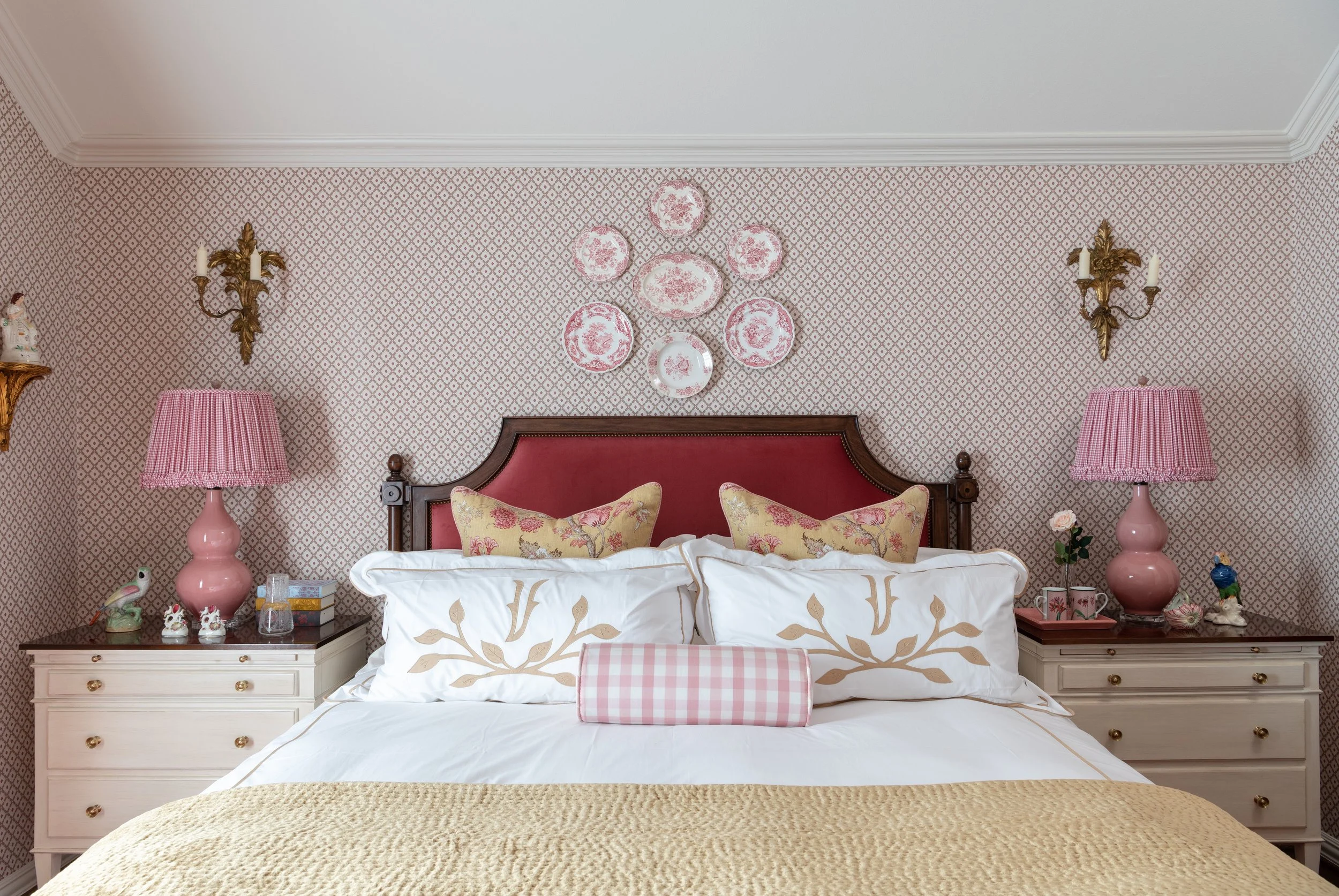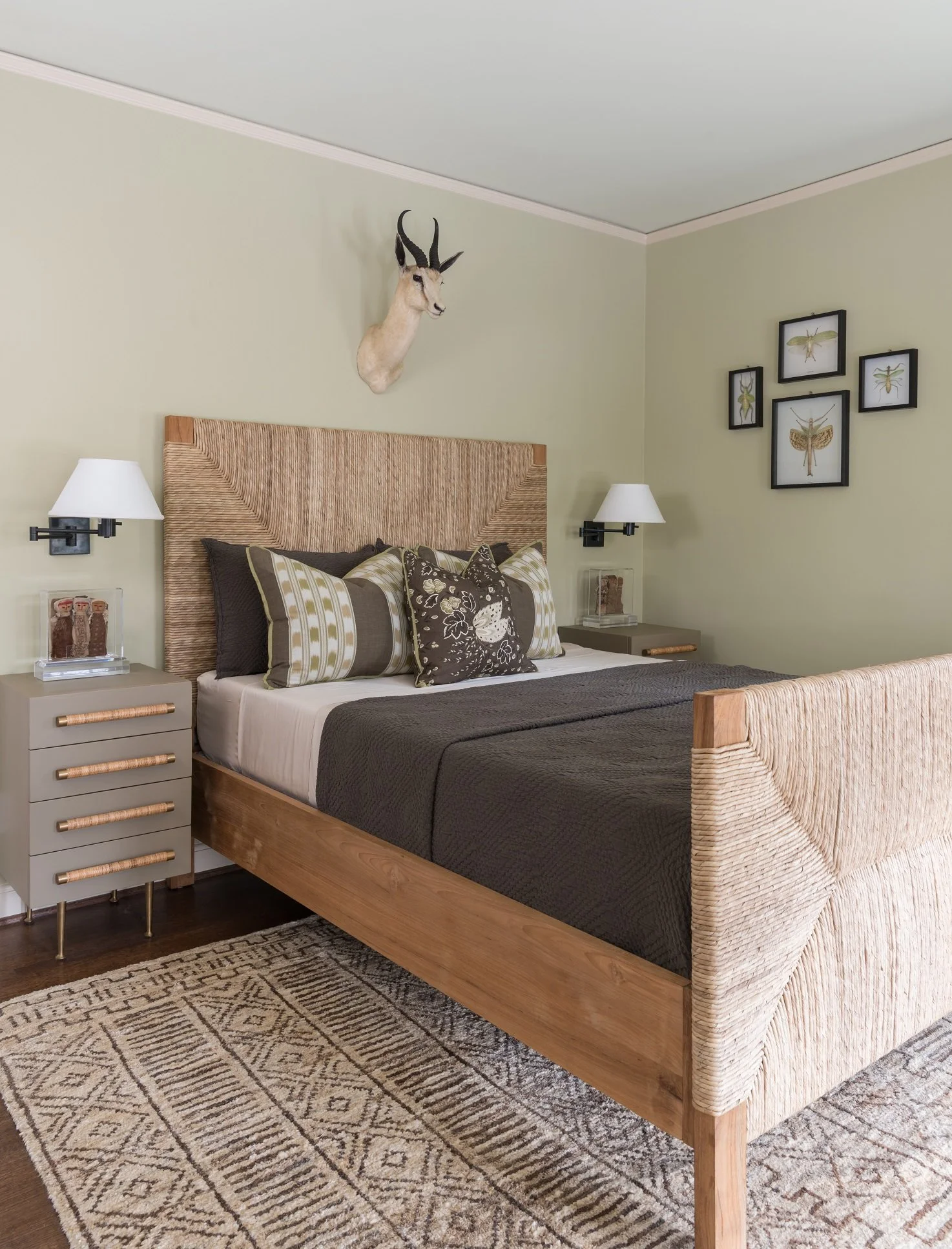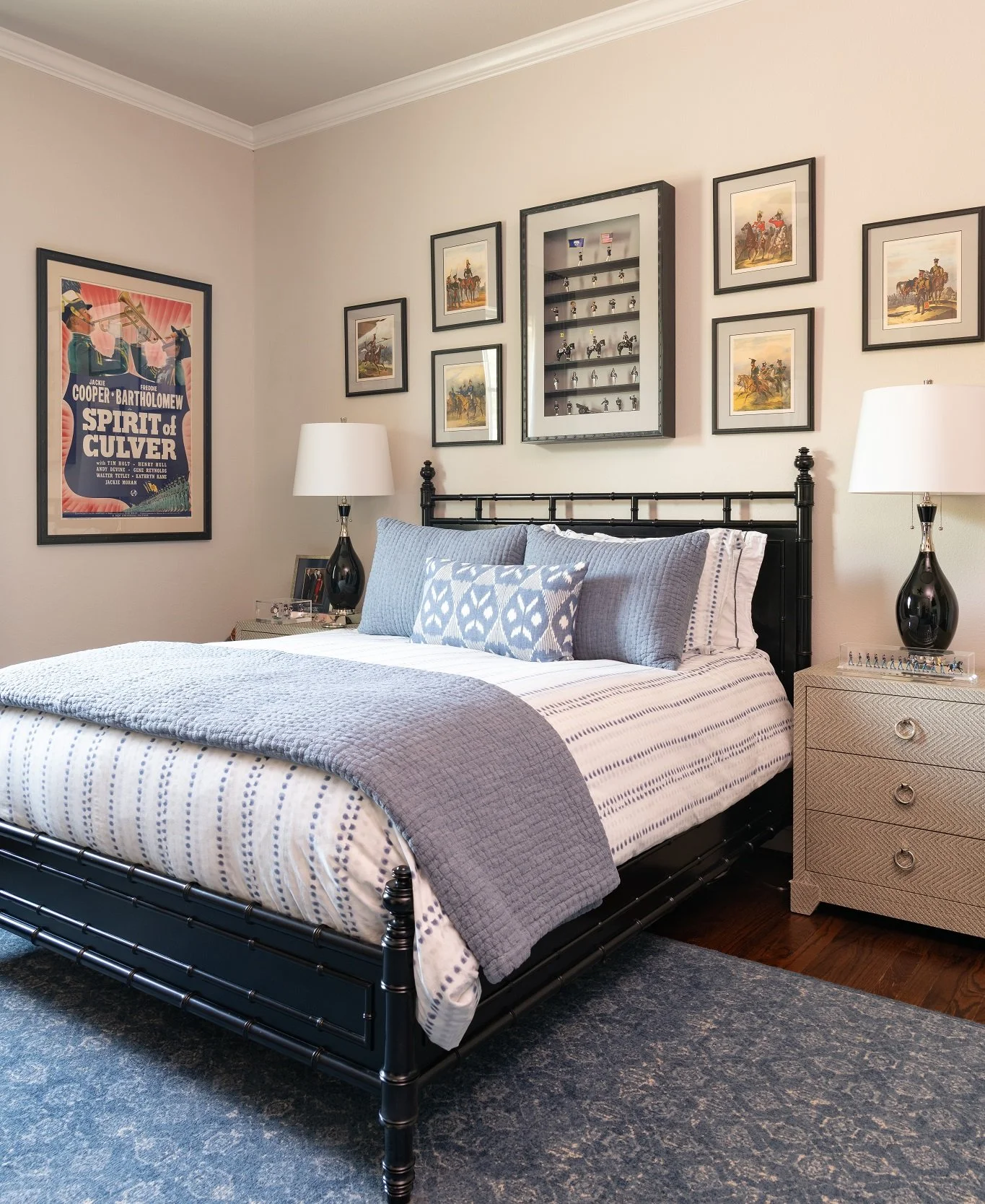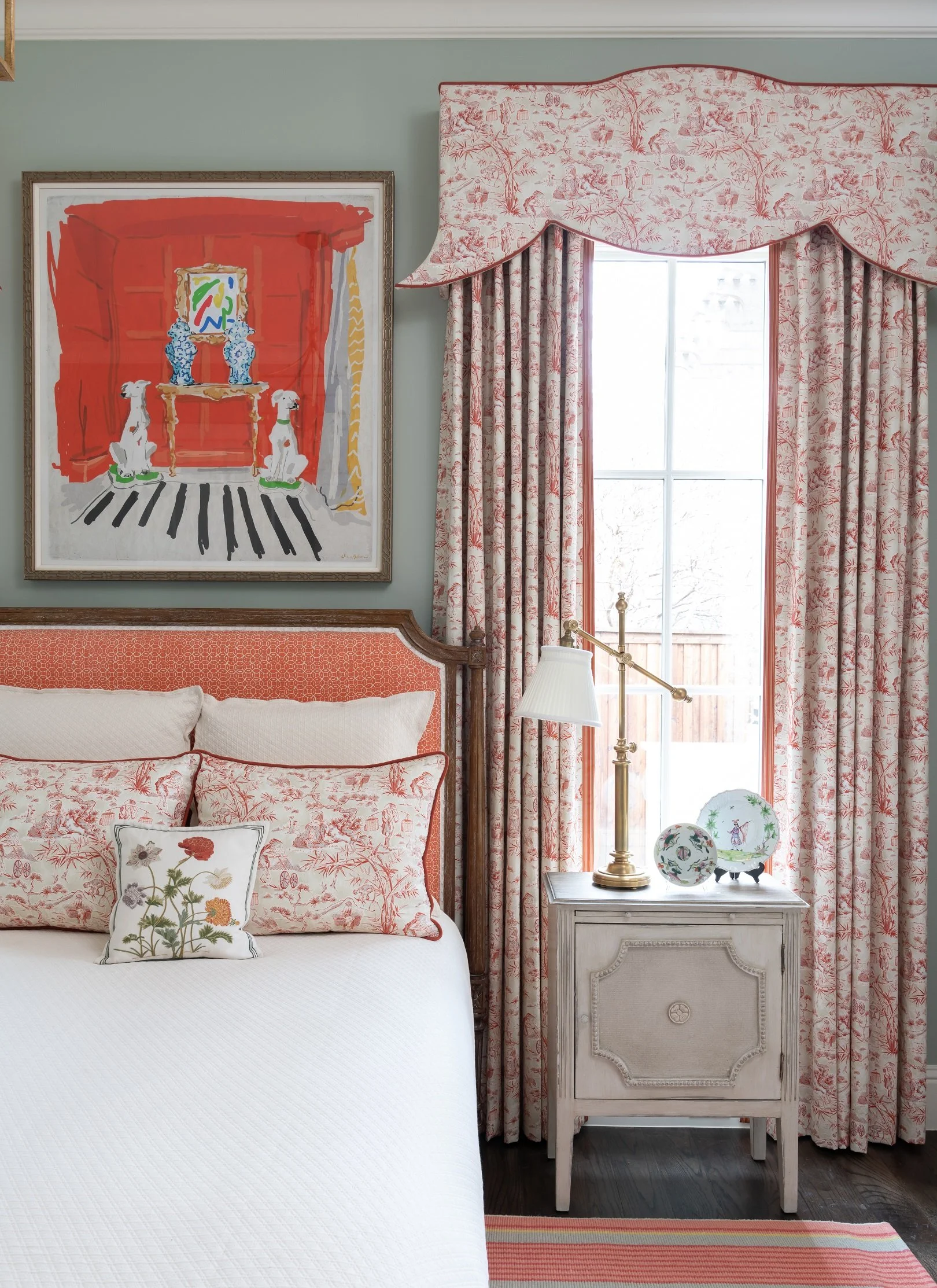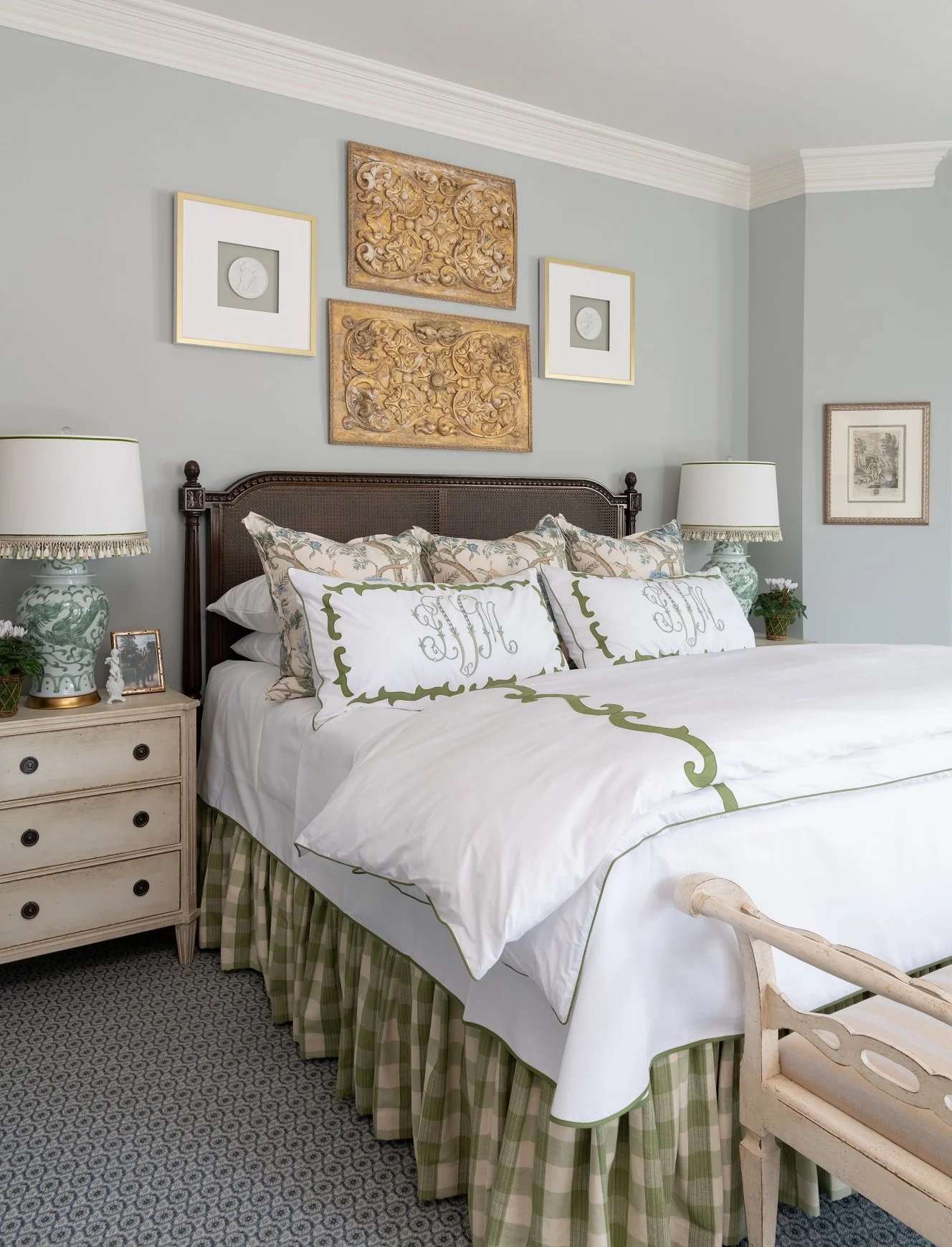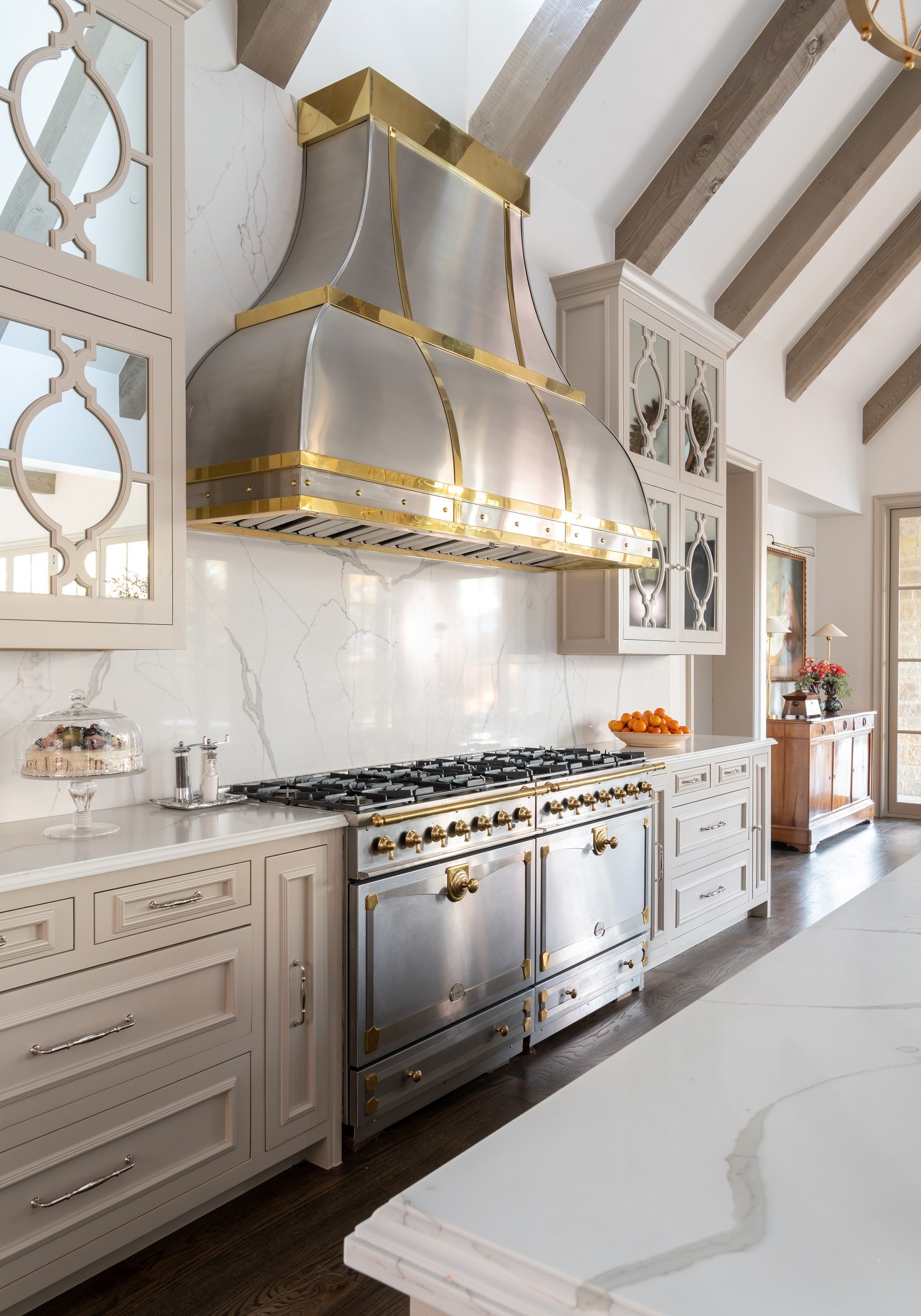A pink-and-white check pillow is the finishing touch for this girl’s bedroom from a Turtle Creek townhouse.
A beautifully made bed makes a world of difference in interior design. Regardless of whether you want an upscale or a casual look, combining the right patterns, fabrics and colors will help you create a look that makes you (or your guest) want to dive right in.
When I’m designing a bedroom for one of my Dallas clients, I usually pick the bedding first. After all, the bed is the focal point of the bedroom and sets the mood for everything around it. Following up on my last article about choosing a mattress, this time, I’ll explain how to make your bed look like one you’d see in an interior design magazine.
StylE
A bed’s design style should always go with the architectural style of the house. In a traditional house, the bedding ought to have more detail, such as layered patterns and monogrammed sheets and pillowcases. The pillows are usually stacked, with maybe a bolster in the middle. A throw blanket at the end of the bed completes the look.
For a contemporary house, it’s more appropriate to design a sleek and simple bed, probably with neutral bedding and fewer pillows. You can still have some detail—for example, edged details on the sheets, pillowcases, or Euro pillows—but on the whole, it’s going to be more minimalist. Any bed with a monochromatic color scheme should use a variety of textures.
This Africa-themed guest bedroom in a Kessler Park home has a contemporary feel because of its simplicity and textural elements. The color scheme for the bedding is done in earth tones.
As a side note, don’t worry about whether every piece on your bed serves a function. Even if you never plan on sleeping with the decorative pillows or the throw blanket, they’re necessary for putting the finishing touch on the design. If you really want that professionally made-up look, you need to style your bed the same way you’d style a shelf or a table setting.
Color Scheme
You can create your bedding color scheme by picking a basic color that complements the rest of your bedroom. Then, build off that color by working with different shades of the same color family.
All-white bedding is popular because it promotes a feeling of relaxation. Since white linens will go with any other color, they’re a good base in case you want to change your duvet and pillows with each season. Blue is probably the next most popular color scheme for bedding. While white is elegant and refined, blue has more of a casual and coastal feel.
If you only want a touch of color, you could use your boldest color on your fitted sheet (which won’t be visible most of the time) or the throw pillows. Since the bedspread is the largest item, choosing a boldly colored bedspread will create the biggest impact. If your bedspread and pillows are colorful, it’s strongly recommended to choose white sheets and sleeping pillows. The white pillows and folded-down top sheet (if visible) will help break up the areas of color and give the eye a place to rest.
Blue-and-white is a classic color combination. It can instantly give bedding a refreshing and uplifting feel. Seen here is a boy’s bedroom from a Preston Hollow home we designed.
Love patterns? Make sure to break up the patterns in your bedding with some solid colors too so that the bedding is not too “busy.” To unite different patterns, make sure both patterns share at least one color. Keep in mind that large patterns are energizing, which is usually not the vibe you want in your bedroom. Small print patterns with subtle colors, however, can be calming.
Sheets
Your sheets should be the best quality you can afford because your skin comes in contact with them every day. I have a traditional house, Federal in style, so I have a turned-down bed where the coverlet and sheets are folded over. Since my sheets are visible, I like to keep multiple sets of sheets to change things up.
Here are some pros and cons to common sheet materials:
Cotton sateen sheets are silky with a subtle sheen. They are cool to the touch, but also trap some heat.
Cotton percale has a cool, crisp texture that feels like hotel sheets or a button-up shirt.
Cotton flannel sheets are super soft and cozy, making them ideal for the winter months.
Linen can feel rougher than cotton, but it softens up after washing. Its hollow fibers trap the optimal amount of body heat to keep you warm at night while also being soft and supple.
Silk is another soft material. Notably, it absorbs less moisture, meaning you can use beauty products before bed without worrying that they’ll get absorbed by your pillow.
Some people change their bedding with the seasons, using percale sheets in the summer, and flannels in the winter, for example. Linen is a good in-between material for both spring and fall.
Before ordering sheets, measure your mattress height. A tall mattress, such as a pillow-top, may require extra-deep cut sheets. Top sheets should be put in finished side down so that the sleeper can enjoy the soft texture. This way, the finished side will also be visible when you fold the banding back.
Bedspreads
It’s worthwhile to research the different types of bedspreads out there before you buy one. Although the terms “duvet” and “comforter” are sometimes used interchangeably, they are two different things. A comforter is a single piece of quilted bedding that is filled, while a duvet has two parts: the insert and the cover, which fits over it like a pillowcase. Comforters are often larger, spilling over the sides of the bed, while duvets are meant to match the size of the mattress.
Quilts or coverlets are cool in the summer and warm in the winter, although they are not as warm as comforters. Pinch-pleated or ruched duvet covers add textural depth and interest to a solid-color bed. A reversible duvet gives you two color options; the color on the opposite side can also be folded over partially to create a striking contrast. For an extra-fluffy look, you can put two inserts in a duvet.
This is one of my all-time favorite bedrooms I’ve designed. The matelassé on the bed has a wonderful texture. The pillows have a layered look, with a hand-embroidered center pillow in front of a pair of Asian toile pillows. The upholstered headboard is within a stained French wood frame.
In my design projects I use a lot of matelassé bedspreads, which have a quilted-like fabric, because they’re washable. I work with several brands that carry “semi-custom” items, where we can pick a fabric from a line and have it made. Buying semi-custom bedding, as opposed to fully custom, makes putting together a bed quicker and more affordable.
The first thing to wear out on the bed is the coverlet or duvet cover because people sit on their beds to watch TV or read a book, or let their kids and pets get on the bed. I always recommend that people get an extra duvet or matelassé in case they need to send one out to be cleaned.
When you fold your bedspread, I suggest folding it in half, and then pulling it back towards you into thirds, past the rows of pillows. Pulling it back gives the pillows more “breathing room” and creates more depth.
Pillows
Decorative pillows are a must for adding more style, texture, or color to your bed. An odd-numbered, asymmetrical arrangement keeps things casual, while a symmetrical arrangement looks more formal. The pillows in front need to be smaller than the ones in the back so you can see behind them.
The number and size of the pillows you should use depends on the size of your bed. For example, a queen bed can have two Euro pillows stacked on each side in the back, two shams or larger throw pillows in the middle, and then either two throw pillows or a lumbar pillow in front. A king bed needs three pillows at the head of the bed. Sleeping pillows can be hidden at the back behind the Euro pillows.
If you have a pretty headboard, you may want to show it off by using fewer pillows. For lumbar pillows, consider placing a round decorative pillow in front; it’ll contrast nicely with the rectangular shape behind it.
This green check bed skirt matches the green detailing on the duvet and pillows. Notice how the sleeping pillows are stacked and hidden behind the decorative pillows.
Bed Skirts
A bed skirt—also known as a dust ruffle—goes between the mattress and the box spring, hiding the lower part of your bed. You’ll definitely want a bed skirt if you store items under the bed. Although bed skirts are mostly decorative, they also help keep dust from accumulating under the bed.
Throw Blankets
Throw blankets, like throw pillows, can be swapped out with the change of season for an easy update. A throw blanket isn’t just for decoration; it also gives your guest another layer for warmth. They are sometimes draped across the bottom of the bed at a diagonal angle. Regardless of bed size, any blanket or quilt you put on the bed needs to be long enough that both ends could drape off the sides. Knitted, velvet, and mohair are all good materials for textural throw blankets.
Adding a throw blanket to the end of the bed creates a more interesting and layered look, especially if the rest of the bedding is understated.
Updating a single bed is easy if you follow these guidelines, but updating multiple beds in the house can get much more complicated. An interior designer like myself can streamline that process for you, should you choose to work with one. Whether you style your beds yourself or work with a professional, I think you should really like what you put on your bed. Use your favorite colors, patterns, and textures; that way, when it’s done, you’ll enjoy living with it for a long time.
Could the bedding sets in your home use a refresh? Consider bringing in an interior designer to give your bedrooms that “wow” factor. To schedule a consultation with us, call our Dallas office at 214-651-7665 or send an email to info@chambersinteriors.com.

